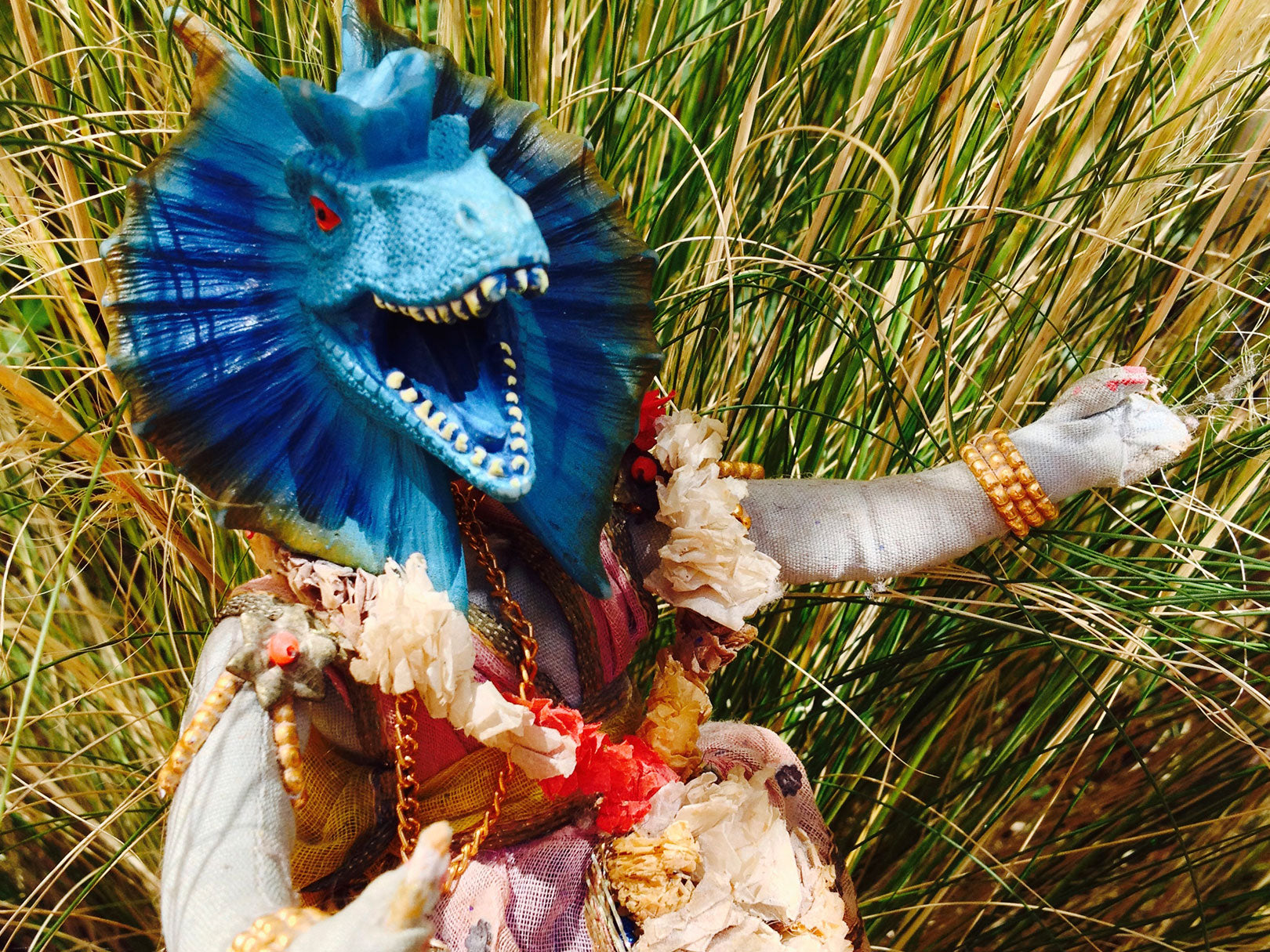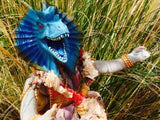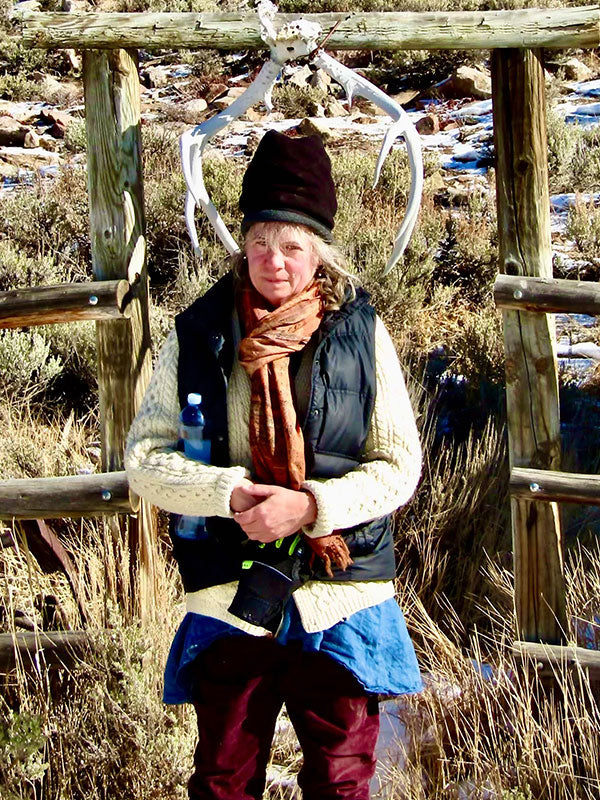Sarah Coleman-Craig
With the imaginative realm of Morphodonia, I hope the possibilities of trans-species evolution and anthropomorphic existence will inspire increased diversity of self expression and resilience for all people.
A friend here in the rural Colorado mountain valley I now live in, referred to the dolls I make, as a type of art activity called “Mojo”. A kind of mashup, like myself. I am an East Coast city girl with roots in the deep South, but I found my home in the West, the land of adventure and open spaces.
Since 2008 I have created hundreds of dolls, been swept up in the creative endeavors of comrades, buried my husband and both my parents. The creatures of Morphodonia began as a something of a distraction from the grueling anxiety of intensive caretaking, becoming a haven for personal freedom, a source of deep amusement and a vehicle for me to communicate with others by inviting them into my imagined world – parallel to planet Earth, the world of Morphodonia, a magical place and one of deep time and of course – deep community.
Personal Evolutionary History
I grew up during the 1970’s in the diverse borough of Philadelphia known as “Germantown”, the birthplace of the antislavery movement. My Mississippi relatives are responsible for one of the most grandiose plantations the South has ever seen, consumed by fire, a hubris most shocking. They lost the war and then they lost their home. Needless to say, my parents were intent on seeing that I find a morally more sustainable path. I went to the tiny, semi utopian Green Street Friends School, where I was steeped in the Quaker methods of abolition and deep community, a comforting backdrop to the slow unraveling of my parents and their imminent divorce.
My father, a frustrated intellectual with a couple of political science manuscripts under his belt, left to work for the Dept of Energy under president Carter, excited by the potential of solar energy initiatives. Back in Philadelphia, my mother, renovated old Victorians, applying her exceptional design skills, learning electrical and plumbing skills, coming home exhausted from sanding floors. I attended an urban experimental magnet school called AMY (Alternative Middle Years), where I was exposed to the diverse and dynamic cultural riches of city life. It was wild.
For 9th grade I transferred back to a private Quaker school, unfortunately more of prep school, and I hated it passionately. My mother and I both struggled with depression. We relocated to Durham, NC where my mother started selling real estate and I found the second closest thing to academic utopia at the intentionally integrated Carolina Friends School, a hippie school out in the country that began with a week of summer camp, a vibe pretty much sustained throughout the year.
My mother and I both continued to struggle with depression. Emotionally and financially the pain of the divorce lingered on. We weren’t doing each other any good and my mother was at her wits end. I didn’t want to leave my school, and my mother was seriously considering a halfway house for me. Desperate, I stood up during “Morning Worship” and asked my community for support. Kara Ikenberry petitioned her family to let me live with them for the last two years, of high school. This was like deep community amplified, and miraculously, the depression started to lift.
My father found his soul mate with a brilliant editor and writer by the name of Diane Hammond. As the Reagan era descended, they departed DC together and headed for Colorado which is where I began to spend summers and holidays. I was a fashion obsessed teenager carting duffle bags of collected materials for potential modification as I bounced back and forth, hoping to create vast universes of color and texture - new worlds to live in, but didn’t know where to start. I was (and still am) a dreamer.
Out of high school I spent a couple winters in Crested Butte, Colorado cleaning condos, washing dishes and trying my hand as a seamstress making play clothes to wear at Dead shows. I took a couple classes at Penland Craft School with early surface design pioneers such as Lenore Davis and Bird Ross, learning assorted fabric modification techniques that defied the ordinary. I considered design school but wasn’t confident that was where I belonged. Back in NC trying to figure it out and help my mother with a career transition, I fell in love, like driving off a cliff to the point of no return, devastating and exciting all at once.
Christopher Craig and I relocated to Santa Fe in 1990. For a decade we juggled a variety of service jobs while pursuing our respective creative endeavors. As a pastry chef I obsessed over texture and flavor combinations, weaving a gastronomical tapestry of pleasure; a restaurant review described my tiramisu as “better than sex”, not exactly my intention, but confirmation I was doing something right. However, the brutal repetition of production and a series of back injuries made it clear I would need to find another way to make a living.
In 2008, after two frustrating years working at Warehouse 21, my close friend and coworker, Vince Kadlubek left the organization and convinced a small group of artists to pitch in on the rent for what would become the arts collective, Meow Wolf. I had the extreme pleasure of participating in the early Meow Wolf production "Biome Neuro Norb".https://www.sfreporter.com/arts/2008/05/21/biome-sweet-biome/. This free for all science fiction fantasy art explosion kicked open the door of my imagination. Vince and I visited the home of Laura Stanziola where he gathered pictures and printed material to compose a narrative for the installation. I acquired a handmade fabric head which I affixed to the body of a toy insect and experienced a jolt of excitement that has never left. When possible, I continued to contribute dolls and other recycled assemblages into other Meow Wolf productions, including The Due Return and The Moon is to Live On.
Morphodonia art dolls have been featured in Meow Wolf retail stores since it's opening in 2016 and Meow Wolf is our exclusive retail partner.
For a while I made shrines around vintage photographs of scowling toddlers, integrating architectural components such as rusted metal, crab shells, feathers fabric, beads, birds nests, camera lens, bike gears and whatever else sparked my interest. I considered these as intuitive divinations of soul and spirit, engineering environments of safety and comfort for the dead. At the time, my father criticized them for being “sentimental”, a family trait I do believe.
College had seemed out of reach for a long time for a variety of reasons. I would have to finance it myself and had tremendous anxiety at the thought of personal exposure under something less than a utopian environment. Sheltered much? For eight years I juggled a variety of part time jobs, attending community college before transferring to UNM. One of these part time jobs, ended up being at Warehouse 21 a radical teen art center in my neighborhood, which opened up a whole can of worms, including the creatures of Morphodonia.
I taught recycled art workshops via Site Santa Fe, Warehouse 21 and Santa Fe Secondary before I had any idea of what I was really doing. I was interested in the potential for individual and collective transformation through the experience of deep community and recycled art was just a way for me to begin talking about this. A physical object, like a mental object, a symbol - once modified, is no longer just an object but rather a vehicle for a new language. Which opens a door for another way of thinking, another way of being.
With my beloved mentor at UNM, Regents professor, Vera John-Steiner, I studied psycholinguistics, creativity and collaboration, thought and language, while watching a hotbed of creative insurgency unfold at Warehouse 21. Not a utopia, but rather a cauldron of conflict and competing forces, a fire was being lit under me that I simply could not ignore. It was the desire to create and so much more.




